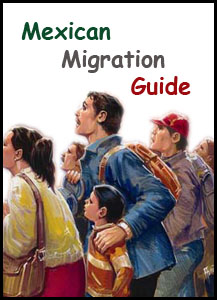O Tempora, O Mores! (February, 2005)
American Renaissance, February 2005
Border-Jumper’s Guide
The Mexican government is handing out a guide that tells Mexicans how to immigrate illegally to America. First published in December by Mexico’s Foreign Ministry, the 32-page booklet, called The Guide for the Mexican Migrant, is in comic book format and is distributed as a free supplement to El Libro Vaquero, a popular cowboy comic book. Mexico plans to hand out 1.5 million copies in five Mexican states that send many migrants to America, and in consulates in the US. The book offers advice on how to cross the Rio Grande and the desert. It tells migrants that thick clothing will increase their weight when wet and make it hard to swim. Border-crossers should avoid walking in the desert when the heat is intense and follow power lines or train tracks if they get lost. They should add salt to their water because it will help them retain liquids.
The book also gives advice on how to deal with Border Patrol officers: “Don’t throw stones or other objects at the officers, since this is considered a provocation.”
Once they have reached the US, they should lie low. “Avoid attracting attention, at least while you are arranging your stay or documents to live in the United States. The best formula is not to alter your routine of going from work to home.” “Avoid family and domestic violence. This is a crime in the United States, just as in Mexico.”
The book contains a disclaimer saying it is not intended to promote illegal immigration and warns against crossing the border illegally. However, it offers no information about how to apply for a visa.
Mexican authorities say the book is intended only to keep border-jumpers safe. “We are not inviting them to cross, but we’re doing everything we can to save lives,” says Elizabeth Garcia Mejia of Grupo Beta, a Mexican government agency concerned with the welfare of Mexican migrants.
The reaction of the US government to the book has been mixed. A Border Patrol spokesman defended the book. “If they’ve already gone ahead and made that decision to cross illegally . . . then anything that helps protect their lives is worth it.” However, a Homeland Security official said his agency was shocked to hear of the book and that the US was seeking an explanation from Mexico.
The reaction among immigration-control groups was not mixed. According to John Vincent of Americans for Immigration Control, “It really looks like the Mexican government is encouraging illegal immigration. It shows the contempt Mexico has for our laws.” Others have pointed out that Mexico encourages illegal immigration because the $15 billion migrants sent home from the US last year was Mexico’s second biggest revenue source, after oil. [Chris Hawley, Mexico Publishes Guide to Assist Border Crossers, Arizona Republic (Phoenix), Jan. 1, 2005. Guía del Migrante Mexicano (Mexican Migrant Guide), Mexican Secretariat of Foreign Relations website.]
Mexico has produced other guides with tips for border-crossers, though not in comic book form. Grupo Beta also has agents at the border telling illegals such things as how much water to take and what clothing to wear. These lectures typically end with, “Have a safe trip, and God bless you!” This summer Grupo Beta put water barrels for illegals in the desert just south of the Arizona border. [Mexico Puts Water Barrels in Desert for Migrants, Reuters, Jun. 9, 2004. Solomon Moore, Mexico’s Border-Crossing Tips Anger Some in U.S., Los Angeles Times, Jan. 4, 2005.]
Three Grupo Beta members were among the 42 Mexican government workers arrested in March by Mexican authorities for smuggling illegal aliens into the US. Police officers and employees of the National Immigration Institute, Mexico’s border enforcement agency, were also part of the gang. They told border-crossers about police raids, illegally freed captives, and let others cross with false documents. Most of the immigrants were Brazilians, Cubans, Central Americans and Asians. [Louie Gilot, Mexican Officials Accused of Trafficking Immigrants, El Paso Times, Mar. 25, 2004. Dudley Althaus, Mexico Casts Net On Human-Smuggling Trade, Houston Chronicle, Mar. 24, 2004.]
Mexico also sponsors the Instituto de los Mexicanos en el Exterior, or the Institute of Mexicans Abroad. This group uses databases of Mexicans in the US to gather crowds to pack the galleries of state legislatures and city councils whenever there is a vote on immigration. Such a crowd was on hand during the California legislature’s debates in 2003 over whether to give driver’s licenses to illegals. When an assemblyman complained, “This bill paves the way to Aztlan!” everyone in the gallery stood up and applauded. When the city council of Holland, Michigan debated whether to accept Mexican consular IDs, a Mexican official brought a mob of his compatriots to the meetings. The meetings became so contentious that the city council postponed the decision. [Matt Hayes, Is Mexico Thwarting U.S. Immigration Enforcement? FOXNews. com, Mar. 18, 2004.]
Burka Bandits
Police and the FBI in Philadelphia are looking into armed robberies by a gang dressed in burkas, the traditional head-to-toe robe Muslim women wear. Police say the burka bandits have struck convenience stores, restaurants, and gas stations at least ten times, and have held up four banks. Police aren’t sure if there is a single gang, or copycats. Although it is hard to identify a robber in a burka, police are looking for a black man and a black woman, and a third person of unknown sex and age. They think there may be as many as five people in the gang. [G.W. Miller III, Burka Bandits, Philadelphia Daily News, Dec. 22, 2004, p. 3.]
One to Miss
Warner Brothers is filming a movie version of “The Dukes of Hazzard,” a popular ABC television series that ran from 1979 to 1986. It was about two “good ole’ boys,” Bo and Luke Duke, and their comic adventures in fictional Hazzard County, Georgia. The program is perhaps best known for the car driven by the heroes: a bright orange 1969 Dodge Charger called the General Lee, with a big Confederate Battle Flag painted on the roof and a horn that played a few bars of “Dixie.” The car became a pop-culture icon; fans bought more than $100 million worth of General Lee licensed products.
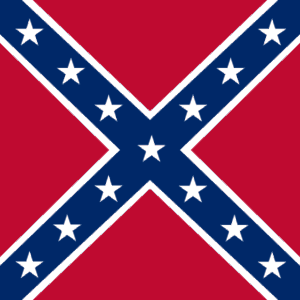
Despite the enduring popularity of the General Lee, studio executives are afraid that if they keep the flag on the car they will be accused of promoting “racism.” They want fans of the television program to watch the movie, and are afraid they will be angry if the flag is gone. Therefore they will keep the flag, but point out that it is an “inappropriate symbol of the dark past.”
In a draft version of the script, a mechanic paints the flag on the roof while repairing the car. The Dukes do not notice, and are surprised when some people cheer as they drive around and others boo. It takes a run-in with black college students for the Duke boys to understand that the battle flag is not “cool.” When they insist they “don’t want to oppress anyone,” the blacks leave them alone.
DaimlerChrysler, which plans to bring back the Dodge Charger next year, considered doing a cross-promotional tie-in with the film, but decided against it, fearing the Battle Flag would “elicit a negative response.” [John Lippman, Flag-Wavering: Adapting ‘Dukes of Hazzard’ Proves Tricky for New Film, Wall Street Journal, Dec. 24, 2004.]
A Profile in Madness
Ethnic advocacy and civil liberties groups have used claims of racial profiling to try to stop private companies and government agencies from enforcing the law against non-whites. For example, due to lawsuits filed by the Department of Transportation (DOT), airlines are almost powerless to keep terrorists off their flights. The man most responsible for the suits is DOT secretary Norman Mineta, who once said that a grandmother from Vero Beach, Florida should get the same scrutiny as a young Saudi man. DOT has brought lawsuits against American, Delta, United, and Continental Airlines for screening potential terrorists. Though American kept only 11 passengers out of 23 million off its planes in late 2001 and early 2002, DOT still charged them with discriminatory conduct that would “result in irreparable harm to the public” if not stopped.
American took these precautions during government warnings of imminent terror attacks. The airline appears to have acted sensibly: in Paris, it tried to keep shoe-bomber Richard Reid from boarding the flight he tried to bring down. If French authorities had not forced the airline to let him on, he might have been added to the list of discrimination victims in DOT’s lawsuit. American kept others off flights because their names were similar to those on terrorist watch lists. American settled its government lawsuit for $1.5 million, to be spent on employee “sensitivity training.” The other airlines also had to spend money for “sensitivity.” Due to “disparate impact” laws, the courts can judge even race-neutral security regulations discriminatory if they affect people of one race more than others.
The risk of being charged with racial profiling prevents the government from taking basic steps to protect Americans. Before the attacks of Sept. 11, intelligence agents were so tied down by civil rights lobbies they could not investigate what was going on in a radical mosque until someone associated with it committed a crime. Government agencies have more freedom to investigate Arabs now, but operate under severe restrictions. Last year, when the Department of Homeland Security (DHS) asked the Census Bureau to produce a report on the demographics of Arabs, Arab organizations and civil libertarians said this could lead to discrimination. Although the information the Census gave the DHS was publicly available and could have been put together by anyone who understands computers, DHS promised to ban such requests in the future.
The civil rights brigade has struck such terror into immigration agencies that they are afraid to do their jobs. This summer, when the Border Patrol conducted sweeps in Hispanic neighborhoods in California, the Los Angeles Times, La Raza, and other pro-immigrant groups complained of “racism.” Asa Hutchinson, the Department of Homeland Security undersecretary in charge of borders, agreed, denouncing the sweeps as racial profiling. He sent a memo to Border Patrol agents explaining that “preventing racial profiling is a priority mission of this department,” and even announced a special training class to stamp out profiling. [Heather Mac Donald, Homeland Security? Not Yet, City Journal, Autumn 2004.]
White Political Prisoner
Roy Bennett, a farmer in Zimbabwe’s Chimanimani district, won a seat in parliament in 2000 as a candidate of the Movement for Democratic Change (MDC), the country’s main opposition party. He is a moderate and was popular among blacks as well as whites. He was one of three whites in parliament, and he persistently protested the injustices of Robert Mugabe’s regime.
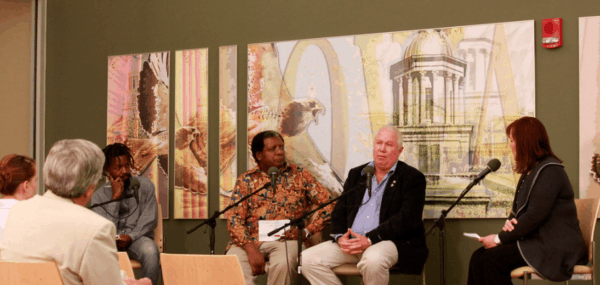
Roy Bennett speaking on democracy in Zimbabwe. (Credit Image: UI International Programs / Flickr)
The government is hostile both to whites and to the MDC, and shortly after the elections, supporters of Zanu-PF, Mr. Mugabe’s party, attacked Mr. Bennett’s farm. They killed two farm workers, raped others, slaughtered cattle, and made Mr. Bennett’s pregnant wife sing ZANU-PF songs in the rain. She miscarried her child. Zimbabwe courts ordered the attackers to stop, but the state and police ignored them. [Judi McLeod, Zimbabwe’s Loneliest Prisoner, Canada Free Press, Dec, 13, 2004.]
On May 19, 2004, Zimbabwe’s Justice Minister, Patrick Chinamasa, told Mr. Bennett in parliament that he would never return to his farm because he was being punished for the sins of his ancestors, who were “thieves and murderers.” Mr. Bennett lost his temper and hit Mr. Chinamasa — though no one was injured. [Zimbabwe MP’s Brawl in Parliament, BBC News, May 19, 2004.]
Normally, a minor assault would be punished by a small fine, if at all. However, a parliamentary committee dominated by Zanu-PF members tried the case and sentenced Mr. Bennett to a year in prison with hard labor. He currently shares a filthy, lice-infested cell with 38 other convicts and his skin is blistered from working in the searing sun. Initially his guards forced him to work bare-headed, but now he is permitted to wear a hat. [First Score for ‘Free Bennett’ Campaign, Sunday Argus (Cape Town), Dec. 19, 2004.]
Mr. Bennett’s friends and family have organized the Free Roy Bennett Campaign to publicize his plight. According to the campaign website (www.free roybennett.com), “Free Bennett” graffiti is appearing throughout the country, and the campaign has received e-mail and letters of support from thousands around the world, including some foreign governments. [William Saunderson-Meyer, Graffiti Highlights Rough Deal for Roy, Sunday Argus (Cape Town), Dec. 18, 2004.]
NAACP Felons
On May 24 police arrested Rev. Joe Buckner, Sr., president of the Rapides Parish, La. chapter of the NAACP, on charges of drug possession, firearms possession by a felon, and conspiracy to produce crack cocaine. (The nature of Rev. Buckner’s previous felony conviction is not public information.) Rev. Buckner said he was “looking forward to my day in court to prove I am innocent of all charges.” The state NAACP president, Ernest Johnson, claimed the arrest was police retaliation. In a radio interview, he said Rev. Buckner had been involved in controversies with the police. “So we know that whenever you stand up for what’s right, you have to be prepared for whatever comes at you because, you know, for every action there is a reaction.” Rev. Buckner’s supporters held a march in front of the Rapides Parish Courthouse. [Bill Summrall, Area Has Drug Problem, ‘But We’re Working On It,’ Town Talk (Alexandria, La.), May 27, 2004.]
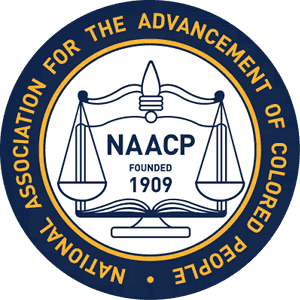
At trial in December, police played tapes of conversations between Rev. Buckner and an undercover officer who sold him cocaine. At first, Rev. Buckner was defiant, turning his back to the prosecutor when she questioned him, but finally, he broke down and cried, threw up his hands and said, “Whatever the questions, the answer is yes.” His lawyer persuaded him to plead guilty to all charges, and Rev. Buckner will serve seven years in prison. [Mandy M. Goodnight, Buckner Pleads Guilty, to Get 7-Year Sentence, Town Talk (Alexandria, La.), Dec. 17, 2004.]
Police arrested Lettie Malone, president of the Mobile chapter of the NAACP, for assault and reckless endangerment on Dec. 22, after witnesses saw her pistol-whip Sheletha Dailey and fire shots at her and her mother. Police found a handgun in Miss Malone’s home like the one witnesses say she used. Miss Malone claims it was just an argument, and that police are retaliating because she filed a complaint against an officer for using racially insensitive language — a charge police say is “absolutely false.” [Mobile NAACP President Charged with Assault, AP, Dec. 22, 2004.]
A federal court convicted Monroe Saulter, president of the Rio Grande, Tex. chapter of the NAACP, of Medicare fraud on Oct. 22. Mr. Saulter owned Quality Therapy Services, a rehabilitation and physical therapy company. He admitted that he defrauded Medicare by charging for phony business expenses and spending the money on himself. He will serve a one-year prison sentence. [Valley Man Sentenced to Prison for Defrauding Medicare, KGBT 4-TV (Harlingen, Tex.), Oct. 22, 2004.]
Unringing the Bell
In 1871, the Reconstruction-era government of North Carolina ordered the University of North Carolina at Chapel Hill (UNC) to admit blacks. Instead the University closed its doors for four years, until Reconstruction ended. To signal the reopening of the all-white University, Cornelia Phillips Spencer, a Confederate widow, writer, historian, and daughter of a prominent faculty member, tolled the bell in UNC’s South Building. For years, UNC students have re-enacted the bell ringing, and in 1994 the University introduced the Bell Award, given each year in honor of Mrs. Spencer to the woman who has made the biggest contribution to UNC.
Two years ago, Yonni Chapman, a black graduate student researching “black freedom and the university” began protesting the Bell Award, saying it honored a “white supremacist.” (Like most Southerners at the time, Mrs. Spencer did not think blacks and whites could live together as equals.) Mr. Chapman also says the campus is littered with buildings named for Ku Klux Klan members and segregationists, and even has a statue of a Confederate soldier.
Last fall, UNC held a symposium to examine its past, and UNC Chancellor James Moeser decided to retire the Bell Award. He says he took a survey, asking several potential recipients if they would accept the award, now that its background was better known. “Their answer was ‘no,’” he says. “A university-wide award ought to be an unalloyed honor and joy. With our current understanding of Mrs. Spencer, the Bell Award is no longer that. As someone said, we now have an award with an asterisk beside its name.”
Chancellor Moeser says he hopes ending the award will stop further efforts to sanitize the campus. Mr. Chapman of course thinks “the victory is incomplete and flawed,” and he would be “dismayed” if UNC did not purge the campus of other “white supremacists.” [Anne Blythe, UNC-Chapel Hill Ends Bell Award, News and Observer (Raleigh), Dec. 17, 2004. Spencie Love, UNC Denigrates Campus Champion’s Memory, Chapel Hill News, Dec. 21, 2004.]
Coasties on Guard
In 1999, the economy of Ecuador nearly collapsed, prompting a mass exodus of illegal immigrants to the United States and Europe. The Ecuadoran government estimates as many as one fourth of it 13 million people fled, and more are leaving all the time.
Since the attacks of Sept. 11, the US Coast Guard has been “pushing our borders out” to the coast of Latin America, intercepting boats trying to smuggle illegals. Since late 2001, the Coast Guard has seized 37 Ecuadoran boats and detained 4,575 illegal aliens. Officials say the sweeps have caught illegals from dozens of countries all over the world. For the last two years, the guard has been sinking unseaworthy boats it seizes — it sets them on fire and blasts them with .50-caliber machine guns.
This upsets people who make a living smuggling people, and annoys the Ecuadoran government. Segundo Moriero-Vegos owned a fishing boat sunk by the Coast Guard in Feb. 2004. He says he “unknowingly” rented it to smugglers who loaded it with 103 illegal aliens and says the Americans “should have brought my boat back here and put it in the hands of Ecuadoran authorities.” His government has protested the sinkings, prompting the US to withhold $7 million in aid. The Ecuadorians say that if the US doesn’t stop, it will end the lease on an American military base used to fight the drug trade.
Other critics note that if another country seized and sank American boats on the high seas we would call it an act of war. They also point out that the best way to keep illegals out is prosecute the American companies that hire them. “As long as we aren’t willing to close our own internal border by pursuing interior enforcement how can we go into other countries?” asks Robert Leiken of the Nixon Center. [Bruce Finley, US Takes Border War on the Road, Denver Post, Dec. 19, 2004.]
Carr Bros. Escape Death?
Jonathan and Reginald Carr, the black killers sentenced to death for torturing and killing five whites in December 2000, may not have to face execution after all. On Dec. 17, the Kansas Supreme Court invalidated the state death penalty law under which the Carrs were sentenced. The justices ruled that the law unfairly favored a death sentence because it required jurors to impose capital punishment when the reasons prosecutors gave to justify it merely equaled the arguments against it. Under the law, a tie meant the death penalty.
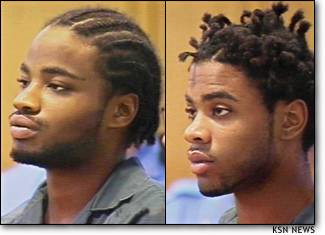
The Carr brothers.
“It puts a thumb on the death side of the scale,” says public defender Rebecca Woodson, who challenged the law. She believes the 4-3 decision means the “death penalty is gone” in Kansas. Sedgwick County District Attorney Nola Foulston, who prosecuted the Carr Brothers, agrees. “This is an enormously significant decision that, unless overturned by the United States Supreme Court, will invalidate every death sentence in Kansas,” she says. Miss Foulston plans to appeal. [Ron Sylvester and Steve Painter, Kansas High Court Rules Death Penalty Unconstitutional, Wichita Eagle, Dec. 17, 2004.]
Revisionism in SA
Pretoria, the administrative capital of South Africa, was named in 1855 in honor of Andries Pretorius, the hero of the Battle of Blood River, one of the most significant events in Afrikaner history. White South Africans celebrated Dec. 16, the date of the battle, as the Day of the Covenant, a sort of Afrikaner Thanksgiving, until the black ANC government changed it to Reconciliation Day. Now blacks want to rename Pretoria itself.
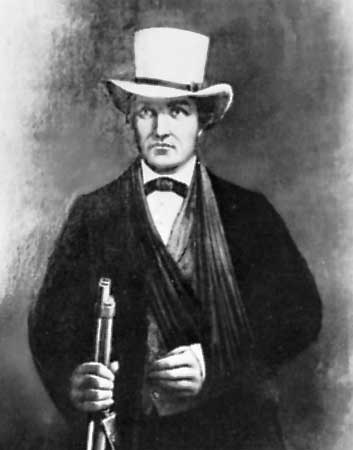
Andries Pretorius
The 142-member city council wants a new name — Tshwane — by the end of this year. Tshwane reportedly means “we are the same” or “we are one because we live together.” It is also the name of a Ndebele chief whose people lived in the area until they migrated north in the mid-1800s. Mayor Smangaliso Mkhatshwa says that while he understands that whites and businessmen object to the new name, if a majority wants it, opponents will have to live with it.
Pretoria is just one name the ANC government wants to sacrifice in order to promote black identity. Its Geographic Names Council examines thousands of place names it considers racist, insulting, or outdated. Eastern Cape Province, for example, may rename itself KwaNtu, Ekhaleni or KwaXhosa. Western Cape Province may keep its old name, but is thinking of changing 11,000 place names. The resort town of George, named after King George, would become Outeniqua. Northern Province already calls itself Limpopo, and has renamed many cities and towns. It has now started on airports and hospitals. Many black South Africans want to change the name of the whole country to Azania. [Michael Wines, All Together Now: Make It ‘Marching to Tshwane,’ New York Times, Jan. 4, 2005.]

